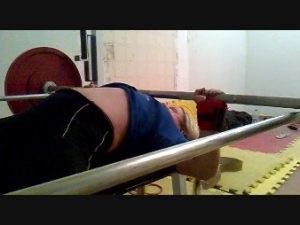Having made my point that all forms of the art are equally legitimate, interesting and honorable, I guess it’s time to understand how different they are.
Actually, this is just part of a much more complicated discussion, which is that each alteration done to a lift performed with a barbell produces a new lift, a new set of mechanical limitations, supercompensation profile and considering that each of the three power lifts is dealt with differently by each lifter (depending on things we have no idea about), we’re not in any easy track.
Let’s stick to just a few differences between raw and equipped lifting. Let’s restrict the discussion even more: let’s stick to squats and bench presses (deadlifts are more mysterious animals, we’ll deal with it later).
During the squat, the lifter flexes the knee joints and the hip joint to the point of highest mechanical disadvantage (“breaking the parallel”). For the moment, let’s avoid calling them “eccentric” and “concentric” phases, since so many concerted muscle actions are taking place that these terms over-simplify what is happening. The extension movements involved in resuming the upright position will suffer different limitations considering the knee joint torque and hip joint torque. For both joints, torque is at its maximum between 70o and 80o. The chief limitation for a squat’s success, therefore, is the muscle strength needed in the extension kinetic chains at those angles.
Both the knee wrap and the squat suit will decrease (how much more or less depends on the numerous possible combinations in equipment use, such as knee wraps only, suit only, both, different kinds of wraps, different types of suit, etc) the strength needed to overcome the external resistance at those angles. The equipment will be less and less effective as the body resumes the straight position to a point where the final effort, also known as “lockout”, is very little aided by the equipment.
We could safely say that the equipment transfers some (and “some” varies from a little to quite a lot) of the difficulty in overcoming the external resistance from the smaller to the widest angles, therefore, from “lifting off” to “locking out”. Both the squat suit and the bench shirt, in very different ways, will do just that. The knee wraps with further enhance the lockout-emphasis effect.
To master equipped lifting, one must work on many aspects of the technique and strength, but, above all, one must master the lockout. The most important assistance exercises target just that. It is easy to understand: once the lifter has perfect control over the lockout and has “negotiated” over 100% loads with his/her Central Nervous System, the lift is good to go.
Raw lifting is, as Shawn Lattimer always said, “a totally different animal”. We’re back to where we started this article, pointing out the angles in which the torques are the highest. The difficulty shifts back to the liftoff phase, instead of the lockout, unassisted phase for the equipped lifting.
Unequipped lifters must master (be strong, stable, proficient) at the liftoff, above all. This is why all the assisted work with boards, chains and bands, regardless of their overall importance in powerlifting, are less important for the raw lifter, relatively speaking. They have their role, since everybody must lockout heavy and stable. But if they fail to liftoff, they won’t get to lockout.
That is where the deads come in: dead benching, dead squatting and all the assistance work targeting strength and control at the liftoff phase of the movement.
I’m still not even mentioning bar path, vertical versus inclined, eccentric control, speed – this is all important and subject for other articles.
My objective here is to shed some light on the nature of differences in training protocols that may show to be helpful for equipped or unequipped lifters.
*ok, I’m not sure what’s going on with youtube: I know I embedded the right videos, but it keeps showing my last uploaded video. Please have patience: I’ll try to fix this.
(Dead squats – with wraps in the last sets, still training for “modern raw” at the time)
(This is band training, but the last part of the video contains some deads)
Read more
Squatting kinematics and kinetics and their application to exercise performance
Kinematic, kinetic and EMG patterns during downward squatting
Effect of squat depth and barbell load on relative muscular effort in squatting.
Explanation of the science behind this:
Squat Analysis (Nice reference list)
A biomechanical model for estimating moments of force at hip and knee joints in the barbell squat
Nice practical articles about the subject:
The Physics of the Bench Press: Science Applied

